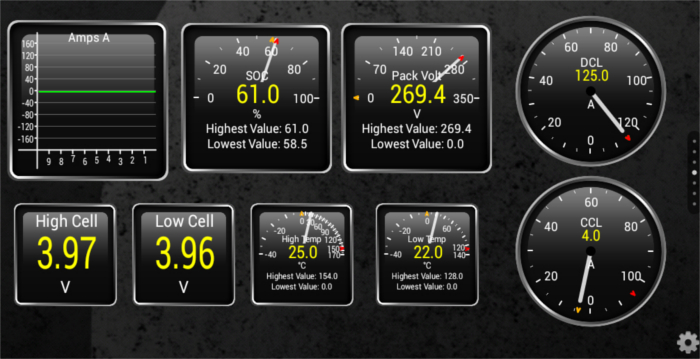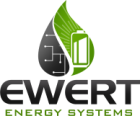Torque is an application for Android tablets and smartphones that interfaces with OBD2 enabled devices (via bluetooth or USB) and provides visual feedback in the form of gauges and digital readouts of the various parameters and values provided. Due to the flexible OBD2 support of the Orion BMS, Torque works cleanly with the Orion BMS out of the box and many Orion BMS customers use this display.
Disclaimer: Ewert Energy Systems is not affiliated with Torque in any way nor does it guarantee support for Torque. Torque is copyrighted by its owners. Please contact the authors of Torque directly for support regarding this software.
Notable Features:
- Integrates seamlessly with the Orion BMS for displaying parameters and viewing & clearing error codes.
- Powerful touch-enabled interface provides easy-to-use display.
- Entire interface is customizable (gauge type, gauge location, gauge look and feel, etc).
- Works on smartphones, tablets and other Android enabled devices (device MUST have USB host or Bluetooth capabilities depending on which adapter is used).
- Can be used to do data logging as well as live web-based performance streaming.
Torque’s Official Website: http://www.torque-bhp.com
Torque’s Official Forum: http://torque-bhp.com/forums
Required items to use Torque with the Orion BMS
- A bluetooth or USB host enabled smartphone or tablet. The device MUST have USB *HOST* or Bluetooth capabilities depending on which adapter is used.
- A compatible bluetooth or USB to OBD2 Adapter. Torque requires an external device to interpret the OBD2 data (either a bluetooth to OBD2 adapter or a USB to OBD2 adapter). Here is a list of Compatible OBD2 Adapters: http://torque-bhp.com/wiki/Bluetooth_Adapters
- The Torque App from Google Play ($4.99 download here)
- An OBD2 connector. These are present on modern vehicles or can be purchased from obd2cables.com. A cable like this one can be used if you do not have an OBD2 connector.
Wiring the Bluetooth/USB OBD2 adapter to the Orion BMS
Torque connects to the Orion BMS using either a bluetooth to OBD2 adapter or a USB to OBD2 adapter which is wired in to the CANBUS network.
One of the CAN interfaces on the Orion BMS must be connected to the OBD2 connector that the OBD2 to bluetooth (or USB) adapter is plugged into. A minimum of 5 wires must be connected to the OBD2 connector to operate:
| OBD2 Pin # | Connect to |
| 6 – CAN High | Orion BMS CAN1 or CAN2 High |
| 14 – CAN Low | Orion BMS CAN1 or CAN2 Low |
| 4 – Chassis Ground | 12v Ground |
| 5 – Signal Ground | 12v Ground |
| 16 – Battery Voltage | +12V (power for adapter) |
Full OBD2 Connector Pinout: http://en.wikipedia.org/wiki/On-board_diagnostics. If an OBD2 cable is needed, please see this cable.
The CAN network requires exactly 2 120 ohm termination resistors at each physical end of the CAN network. For more information on CANBUS wiring, please review the Orion BMS wiring manual (https://www.orionbms.com/manuals/wiring).
Note: The baud-rate of the connected Orion BMS CANBUS interface must be either 250 Kbps or 500 Kbps to conform to OBD2 standards. This setting is available under “Communications Settings” in the BMS Profile section of the BMS utility.
Note: The OBD2 ECU ID may be changed from the default value if this ECU ID is integrated into a vehicle that already uses this ECU ID. It is important that each ECU in the vehicle have a unique ECU ID. This setting is available under “Communications Settings” in the BMS Profile section of the utility.
Configuring Torque
The adapter setup portion of Torque is dependent on what OBD2 adapter is being used. Please consult the official Torque documentation / support forum for assistance getting the adapter interface configured.
The next portion is adding the Orion BMS PIDs (viewable parameters such as battery voltage and current) to Torque. There are two different ways to do this.
Method 1 (Manual Entry – For Novice Users):
- Download the following PDF file: Orion BMS Torque Extended PIDs (PDF)
- Open Torque and go to “Settings” (usually by pressing the bottom left key [looks like an upside down box] on the phone / tablet and then selecting Settings).
- Scroll down in the settings list and click “Manage extra PIDs/Sensors”
- Press the Menu button again (looks like upside down box) and press “Add custom PID”
- Press “OK” to agree.
- Fill out the appropriate information from the List of OrionBMS Torque PIDs, starting with the first PID (or whichever ones are wanted / needed).
- Repeat steps 3 – 5 for all PIDs wanted / needed.
- Return to the Torque main screen by hitting the Back button (backwards arrow) several times.
- Press the “Realtime Information” button on the main screen to go to the gauges screen.
- Long press (press and hold) any area on the screen to bring up a list of options about adding / editing existing gauges. When adding a gauge, the PIDs added manually should be selectable as options.
- The gauges should be updating regularly at this point.
Method 2 (Automatic Entry – For Advanced Users):
Torque provides a secondary method for bulk loading multiple PIDs into memory by reading them in from a file.
- Download the following file to the Android device: Orion BMS Torque Extended PIDs (CSV)
- Install a File Manager application (Astro File Manager is commonly used).
- Open the File Manager and navigate to the home Torque folder (commonly this is ‘/mnt/sdcard/.torque’ OR ‘/.torque’.
- Copy the file downloaded above (“orionbms_pids.csv”) in to the ‘extendedpids’ folder (which should already exist).
- Exit the file manager and re-open Torque.
- Go to “Settings” and then scroll down to “Manage extra PIDs/Sensors”
- Press the Menu button on the device (looks like upside down box) and then press “Add predefined set”
- Select “orionbms_pids” to add them as a predefined PID list.
- Return to the Torque main screen by hitting the Back button (backwards arrow) several times.
- Press the “Realtime Information” button on the main screen to go to the gauges screen.
- Long press (press and hold) any area on the screen to bring up a list of options about adding / editing existing gauges. When adding a gauge, the PIDs added manually should be selectable as options.
- The gauges should be updating regularly at this point.
![]() AN1184 - Copyright (C) 2019 Ewert Energy Systems
AN1184 - Copyright (C) 2019 Ewert Energy Systems

 AN1184
AN1184







